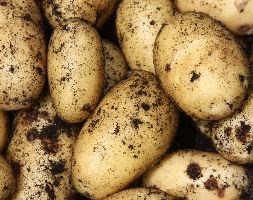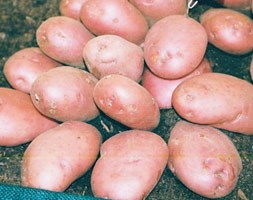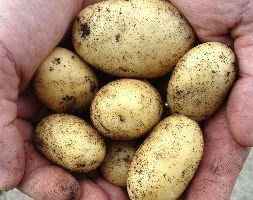Price reductions at Crocus
by Sarah - February 28th, 2016.Filed under: Crocus, Price Reductions.
Crocus reduced the price on these lines today
potato ‘Charlotte’ (potato – second early, Scottish basic seed potato) was £2.49 now £1.24
Position: sun-partial shade Soil: fertile, well drained Rate of growth: fast-growing Harvesting period: mid to late June Hardiness: protect tubers from frost ‘Charlotte’ is a very popular salad variety, which produces pear-shaped, yellow skinned waxy potatoes with creamy-yellow flesh. They are full of flavour and delicious either hot or cold. This variety also has high resistance to foliage and tuber blight. Garden care: As soon as the potato tubers have been delivered you should unpack them and start the chitting (sprouting) process. Place them in single layer in a seed tray without compost and leave in a light, cool area protected from frost. This can be started about six weeks before you intend to plant them. Early varieties can be planted out under frost fleece protection, but the later varieties should be planted after the worst frosts have passed in your area – this is generally mid March to mid April. Dig a trench 8 – 13cm (3 – 5in) deep adding a general purpose fertiliser to the bottom of the trench. Plant the potato tubers in the trenches about 30cm (12in) apart, being careful not to knock the shoots off the tubers, and keeping the shoots facing upwards. Then lightly cover with soil. As the plants get to around 20cm (8in) tall you need to bank up the soil around the plant, so the soil covers the bottom two thirds of the plant. Watering your plants well will help improve crop yield and discourage potato scab.
potato ‘Swift’ (PBR) (potato – first early, Scottish basic seed potato) was £2.49 now £1.24
These come in a ‘taster’ pack of 5 tubers. Position: sun-partial shade Soil: fertile, well drained Rate of growth: fast-growing Harvesting period: June Hardiness: protect tubers from frost Hailed as one of the earliest croppers, it is claimed that you can be dishing these potatoes up in as little as 7 weeks after you plant them. They produce a high yield of white-skinned, oval potatoes that have a creamy coloured flesh that is ideal for boiling. In growth, they are compact, which makes them ideal for containers, and they show a good resistance to scab and virus. Garden care: As soon as the potato tubers have been delivered you should unpack them and start the chitting (sprouting) process. Place them in single layer in a seed tray without compost and leave in a light, cool area protected from frost. This can be started about six weeks before you intend to plant them. Early varieties can be planted out under frost fleece protection, but the later varieties should be planted after the worst frosts have passed in your area – this is generally mid March to mid April. Dig a trench 8 – 13cm (3 – 5in) deep adding a general purpose fertiliser to the bottom of the trench. Plant the potato tubers in the trenches about 30cm (12in) apart, being careful not to knock the shoots off the tubers, and keeping the shoots facing upwards. Then lightly cover with soil. As the plants get to around 20cm (8in) tall you need to bank up the soil around the plant, so the soil covers the bottom two thirds of the plant. Watering your plants well will help improve crop yield and discourage potato scab.
potato ‘Pink Fir Apple’ (potato – maincrop, Scottish basic seed potato) was £2.49 now £1.24
Position: sun-partial shade Soil: fertile, well drained Rate of growth: fast-growing Harvesting period: October Hardiness: protect tubers from frost A Heritage salad potato bred in 1850. This late maincrop potato has knobbly pink skinned tubers of butter yellow, waxy flesh. An unusual potato that’s great as a salad potato but can also be used to make delicious chips – with a single tuber for each chip! It has been given an Award of Garden Merit (AGM) by the Royal Horticultural Society. Garden care: As soon as the potato tubers have bee n delivered you should unpack them and start the chitting (sprouting) process. Place them in single layer in a seed tray without compost and leave in a light, cool area protected from frost. This can be started about six weeks before you intend to plant them. Early varieties can be planted out under frost fleece protection, but the later varieties should be planted after the worst frosts have passed in your area – this is generally mid March to mid April. Dig a trench 8 – 13cm (3 – 5in) deep adding a general purpose fertiliser to the bottom of the trench. Plant the potato tubers in the trenches about 30cm (12in) apart, being careful not to knock the shoots off the tubers, and keeping the shoots facing upwards. Then lightly cover with soil. As the plants get to around 20cm (8in) tall you need to bank up the soil around the plant, so the soil covers the bottom two thirds of the plant. Watering your plants well will help improve crop yield and discourage potato scab.
potato ‘Sarpo Mira’ (PBR) (potato – maincrop) was £4.99 now £2.49
Position: sun-partial shade Soil: fertile, well drained Rate of growth: fast-growing Harvesting period: July Hardiness: protect tubers from frost A high yielding , red-skinned late maincrop variety, ‘Sarpo Mira’ (pronounced Sharpo), produces a good amount of weed-smothering foliage, but it is the potatoes natural resistance to blight that makes it stand out from the crowd. Years of research at the Sárvári Research Trust (SRT), which is a not-for-profit company based at Bangnor university in North Wales, has produced a couple of new varieties with high levels of blight resistance – and this one is regarded as the best of the best. It is a good all rounder in the kitchen and has a floury texture that is great for baking, roasting and making chips. It also has good crop yields and stores well so the good harvest potential will mean you do not have to eat them all at once. Garden care: As soon as the potato tubers have been delivered you should unpack them and start the chitting (sprouting) process. Place them in single layer in a seed tray without compost and leave in a light, cool area protected from frost. This can be started about six weeks before you intend to plant them. Early varieties can be planted out under frost fleece protection, but the later varieties should be planted after the worst frosts have passed in your area – this is generally mid March to mid April. Dig a trench 8 – 13cm (3 – 5in) deep adding a general purpose fertiliser to the bottom of the trench. Plant the potato tubers in the trenches about 30cm (12in) apart, being careful not to knock the shoots off the tubers, and keeping the shoots facing upwards. Then lightly cover with soil. As the plants get to around 20cm (8in) tall you need to bank up the soil around the plant, so the soil covers the bottom two thirds of the plant. Watering your plants well will help improve crop yield and discourage potato scab.
potato ‘Sarpo Axona’ (late maincrop potato) was £4.99 now £2.49
Position: sun-partial shade Soil: fertile, well drained Rate of growth: fast-growing Harvesting period: July onwards Hardiness: protect tubers from frost Another recently introduced late maincrop potato, which like its close relative ‘Sarpo Mira’, has an outstanding resistance to blight. The pink-skinned tubers have a uniform shape and their creamy flesh has an excellent flavour that lends itself well to all methods of cooking. A tasty all-rounder that has good disease resistance – what more could you want? Garden care: As soon as the potato tubers have been delivered you should unpack them and start the chitting (sprouting) process. Place them in single layer in a seed tray without compost and leave in a light, cool area protected from frost. This can be started about six weeks before you intend to plant them. Early varieties can be planted out under frost fleece protection, but the later varieties should be planted after the worst frosts have passed in your area – this is generally mid March to mid April. Dig a trench 8 – 13cm (3 – 5in) deep adding a general purpose fertiliser to the bottom of the trench. Plant the potato tubers in the trenches about 30cm (12in) apart, being careful not to knock the shoots off the tubers, and keeping the shoots facing upwards. Then lightly cover with soil. As the plants get to around 20cm (8in) tall you need to bank up the soil around the plant, so the soil covers the bottom two thirds of the plant. Watering your plants well will help improve crop yield and discourage potato scab. Photography of potato ‘Sarpo Axona’ courtesy Alan Romans
potato ‘Kifli’ (early maincrop potato) was £4.99 now £2.49
Position: sun-partial shade Soil: fertile, well drained Rate of growth: fast-growing Harvesting period: July onwards Hardiness: protect tubers from frost Forming part of the new breed of sarpo potatoes, which show an excellent resistance to blight and potato virus, this early maincrop cultivar is also resistant to drought. ‘Kifli’ will produce tasty, white-skinned potatoes that have a particularly good flavour when harvested and cooked straight away. More mature tubers still maintain a good flavour though, so they can be harvested over a long period. It is known to be a slow starter, so it is best started off a little earlier than you normally would. Garden care: As soon as the potato tubers have been delivered you should unpack them and start the chitting (sprouting) process. Place them in single layer in a seed tray without compost and leave in a light, cool area protected from frost. This can be started about six weeks before you intend to plant them. Early varieties can be planted out under frost fleece protection, but the later varieties should be planted after the worst frosts have passed in your area – this is generally mid March to mid April. Dig a trench 8 – 13cm (3 – 5in) deep adding a general purpose fertiliser to the bottom of the trench. Plant the potato tubers in the trenches about 30cm (12in) apart, being careful not to knock the shoots off the tubers, and keeping the shoots facing upwards. Then lightly cover with soil. As the plants get to around 20cm (8in) tall you need to bank up the soil around the plant, so the soil covers the bottom two thirds of the plant. Watering your plants well will help improve crop yield and discourage potato scab. br> Photography of potato ‘Sarpo Kifli’ courtesy Alan Romans
potato ‘Jazzy’ (potato – second early, Scottish basic seed potato) was £4.99 now £3.99
Position: sun-partial shade Soil: fertile, well drained Rate of growth: fast-growing Harvesting period: May – June Hardiness: protect tubers from frost Jazzy is a new small potato That has has a waxy set skinned variety it hasalready won the prestigous Royal Horticultral Society Award of Garden Merit. Taste wise its bursting with flavour and very versatile. It is suitable for boiling steaming and mash as well as roasting with exceptional flavour Garden care: As soon as the potato tubers have been delivered you should unpack them and start the chitting (sprouting) process. Place them in single layer in a seed tray without compost and leave in a light, cool area protected from frost. This can be started about six weeks before you intend to plant them. Early varieties can be planted out under frost fleece protection, but the later varieties should be planted after the worst frosts have passed in your area – this is generally mid March to mid April. Dig a trench 8 – 13cm (3 – 5in) deep adding a general purpose fertiliser to the bottom of the trench. Plant the potato tubers in the trenches about 30cm (12in) apart, being careful not to knock the shoots off the tubers, and keeping the shoots facing upwards. Then lightly cover with soil. As the plants get to around 20cm (8in) tall you need to bank up the soil around the plant, so the soil covers the bottom two thirds of the plant. Watering your plants well will help improve crop yield and discourage potato scab.













